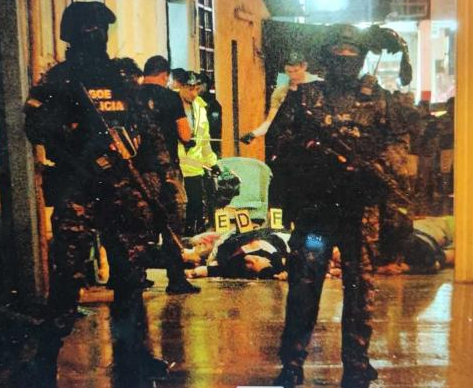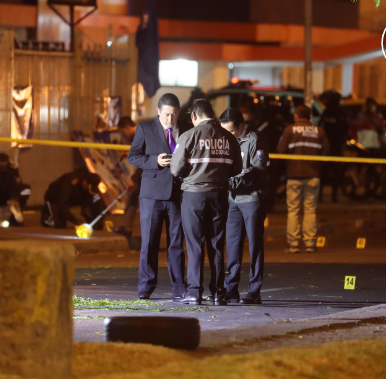Mexican drug cartels play major role in Ecuador’s plague of violence — and now an assassination– but sorting out all the ‘bit actors’ is difficult
By Pablo Ferri
No other country handles such a high ratio of tons of cocaine per capita as Ecuador. The South American nation, a hinge between the two major coca leaf producers in world, Colombia and Peru, has become logistical platform for large transnational criminal organizations over the past 15 years. Among these, the Sinaloa Cartel stands out. The Mexican criminal group has nearly half a century of experience in smuggling drugs to the world’s largest consumer market, the United States.
transnational criminal organizations over the past 15 years. Among these, the Sinaloa Cartel stands out. The Mexican criminal group has nearly half a century of experience in smuggling drugs to the world’s largest consumer market, the United States.
The assassination of Fernando Villavicencio, a candidate for the presidency of Ecuador, has been linked to drug cartels. Villavicencio had consistently spoken of threats and intimidation against himself and his team by Los Choneros, an alleged ally of the Sinaloa Cartel in Ecuador. Villavicencio accused the gang’s suspected leader, known as Fito, of sending him threatening messages. Fito apparently had been angered by Villavicencio using his name in interviews with the media as an example of the crime and corruption that plague the country.

Police at the scene of a deadly gang-related shooting in Guayaquil in February.
Villavicencio was shot dead in Quito on Wednesday, and everything appears to point directly to Los Choneros, a criminal group that emerged on the northern coast of Ecuador in the late 1990s. However, hours after the assassination, a group of hooded men dressed in black released a video claiming responsibility for the attack. In the video, one of them claimed to be a member of Los Lobos, a splinter group of Los Choneros, and accused Villavicencio of not fulfilling some kind of agreement.
Things became even more complicated Thursday when another group of men, dressed in white and with their faces visible, also released a video claiming to be true members of the “GDO [organized crime group] Los Lobos,” and denied any involvement in the candidate’s assassination. Whether or not Los Lobos were responsible has led to speculation about the group’s international relations, specifically their alleged links to Mexico’s emerging brand of organized crime, the Jalisco New Generation Cartel (CJNG), a rival of the Sinaloa Cartel.
Sinaloa or Jalisco: that is the question. Beyond names and identities, their presence in the equation requires an understanding of their role in the dynamics of Ecuadorian organized crime. How do supposedly transnational criminal alliances influence the workings of local criminal activity? In an interview with an Ecuadorian media outlet a month and a half ago, academic Fernando Carrion spoke of a holding logic by which Mexican cartels use gangs like Los Choneros and Los Lobos to transport cocaine, import materials for its production, and other logistical operations.
The numbers highlight the need for cooperation between the criminal organizations. Carrion explained that Ecuador distributes between 700 and 800 tons of cocaine every year. Most of it goes north or east, to the United States and Europe, while some goes to Brazil — the world’s second largest consumer of cocaine and its derivatives — while some remains in Ecuador, feeding increasingly important local markets, a phenomenon common to the rest of Latin America.

Police investigators at the scene of Wednesday’s assassination of presidential candidate Fernando Villavicencio in Quito.
Daniel Pontón, dean of the School of Security and Defense at Ecuador’s Instituto de Altos Estudios Nacionales, explains that the presence of Mexican organizations in the country dates to the early 2000s. “In recent years, posters have appeared in some prisons that mention the CJNG,” he says. Regarding the Mexican influence, the expert imagines a scheme of “contacts,” far removed from standard business logic. “Organized crime does not function as a private company; they are made up of contacts and franchises, letterheads that people from here use based on the contacts they establish and that guarantee security for the management of certain drug-trafficking routes.”
Mexican academic Cecilia Farfán-Méndez assumes that Mexican criminal groups like the Sinaloa Cartel run international drug trafficking networks, but she is cautious about establishing their forms and dynamics. “There is always this discussion of which is the most powerful criminal group, along with its international reach,” she explains. “But the reality is that it is very difficult to gain solid information and concrete data on the expansion of these groups.”
Pontón formulates a similar thesis. “Ecuador’s problem of violence is endogenous: it is ours. Here we have experienced a very particular process of complex violence. Of course, it is largely financed by international organized crime. But I don’t know to what extent the Mexican cartels pull the strings here,” he says. “The truth is that there is little information. A lot of journalistic research has been done, but neither academia nor the institutions have a clear map of what we have.”
“The main problem,” Farfán-Méndez argues, “is that given the number of intermediaries involved in the different illicit economies, what makes someone an affiliate of an organization like the Sinaloa Cartel?” The expert, who directs the Center for U.S.-Mexican Studies at the University of California, San Diego, and has studied the Sinaloa Cartel’s business model, points out that much of the time information on the size of groups comes from interested parties, such as the DEA. In July, the US anti-drug agency estimated that the Sinaloa and Jalisco cartels have around 45,000 members.
The shape and interests of the international chapters of Mexico’s cartels go to the heart of the matter. How much blame do they bear for the rise in homicidal violence in Ecuador? And for the prison violence that has left hundreds dead in the country over the past four years? These are questions that lead to the attack against Villavicencio. Beyond their direct involvement, the criminal methods employed in the north of the continent could be permeating the south.
Farfán-Méndez invokes Los Zetas, one of the best-known criminal brands of the early 2000s. “Los Zetas were the media favorite; they talked about something sophisticated, large, and with firepower. And then in many places, the talk was of the Zetas moving in. If you are a criminal, you have an incentive to say that you belong to a group of some renown. It might help you. I mean, it’s not that there are no relationships, but there are incentives to use brands that can help you extract profits or whatever you’re looking for.”
___________________
Credit: El Pais




















